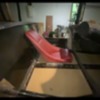Do I need to put a aluminum plate on the bottom of my thunder ranch spyder? How do I mount the seats if not? It doesn't seem like the fiberglass would be strong enough on its own.
Replies sorted oldest to newest
Yes....Some people use fender washers outside under your car's floorboard and inside your seats to sandwich the fiberglass floor and seat together. IMHO, this is minimum.
I used 3" square 12 ga steel plates inside and out. With radiused edges and corners to prevent cutting into the fiberglass.......Bruce
The floor will hold. It's quarter-inch FRP board, made to hold the chairs. Use two-inch fender washers or similar.
Original cars had much thinner aluminum; seats were bolted to racks running from the 2-inch round steel cross tube (not present on replicas) to what I think is an angle reinforcement at the base of the firewall—which your car has.
Or you could also do what I did, which is fabricate cross braces from some 1.5-inch steel C channel and weld those to the frame tubes and that thick plate in the middle of the floor.
Don' forget to notch the rears and weld in different C channel in order to get the seats low enough in the chassis!

I can't speak for the strength of the TR floor, but peop[le often ask about the "fiberglass" floor in a Beck and I can tell you it is a LOT stronger than you think. We've had to do various testing in several different countries and one of the tests we had to do was a tensile pull strength test for the seat and seat belt mounting points, through the floor. So, first off, our (Beck) floor is like described above, it is a core "sandwich" comprised of a layer of composite, a layer of wood (older cars) or a layer of hex core matte (newer cars) and then another layer of composite. It outperformed the minimum pull strength for a steel floor as both seat and seatbelt mounting points by 10x. It is very strong.
BUT AGAIN, I cannot speak for the process TR used, but if it is done anything like what I've described, then it should be very strong.
That said, I've seen lots of alternative mounting styles, many luted above, ranging from steel and aluminum floor plates, welded in crossbars, 2x4 (not a suggestion, I've just seen it) to name a few.
My personal opinion is that the seat belt mounting points are more crucial than the seat itself.
The seat and seat mounting has to do three things:
The seat must physically support your weight.
It should not twist, tilt, or move under extra strain.
It must remain attached to the car and hold you firm in any incident, for example not fall through the bottom of the car in a wreck.
The belts must hold you in place, in a wreck they are loaded MUCH more than you can imagine.





